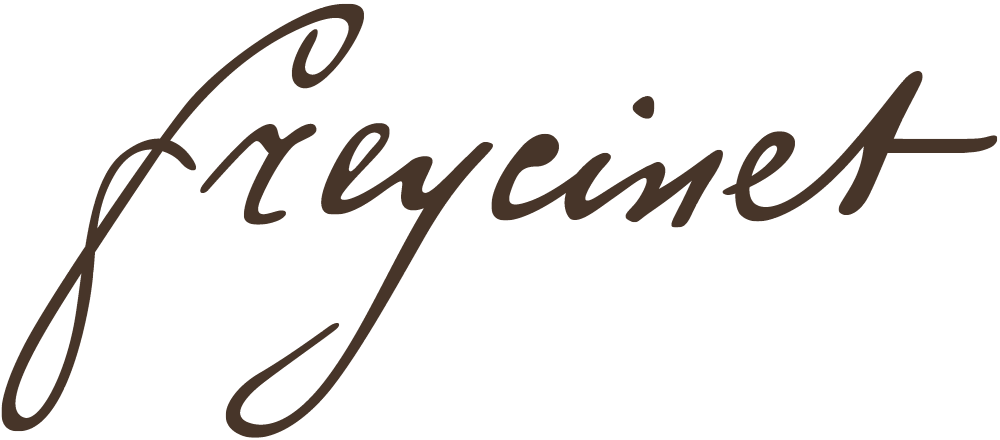An Introduction
The Freycinet Collection of the State Library of Western Australia is a series of eighteen drawings, engravings and watercolours. The images were made during and after two nineteenth-century French maritime expeditions which visited the coast of Western Australia. The first of these expeditions was undertaken by captain Nicolas Baudin from 1800 to 1804 in three vessels: firstly the Géographe and the Naturaliste and later the Casuarina. The second expedition was under the command of Louis de Freycinet in the vessel Uranie (and then the Physicienne) from 1817 to 1820.
The Freycinet Collection is so named because Louis de Freycinet (1779-1842) was a participant in both expeditions, having been an officer on the Naturaliste during Baudin's circumnavigation of Australia. As Baudin died in Mauritius in 1803, Freycinet was responsible for many of the maps published as a result of the expedition and took on the task, with François Péron, of completing the official account of the voyage. By 1816, France was displaying a newfound interest in maritime exploration to restore national prestige in the wake of the humiliating downfall of Napoleon. Freycinet took advantage of this revival and, that year, submitted a proposal to the Ministry of the Interior for, and was granted command of, an expedition to circumnavigate the globe.


Watercolour and ink drawings of a crowned baler at Shark Bay, Western Australia in 1818
Both the Baudin and Freycinet expeditions had mostly scientific objectives.
During the eighteenth century the driving force behind European
maritime travel had begun shifting towards the pursuit of greater knowledge of the mysteries of the
Earth. It was the Age of Enlightenment, a time devoted to reason,
science and progress. Maritime voyages of exploration played a vital
role in advances in a wide range of scientific disciplines including
botany, zoology, taxonomy, astronomy, geology and anthropology.
The names of Baudin's and Freycinet's vessels — the Naturaliste (naturalist), the Géographe (geographer), the Uranie (Urania, the muse of astronomy) and later the Physicienne (physicist) — attest to the primacy of scientific endeavour on these French expeditions of the early nineteenth century. Both expeditions contributed large botanical and zoological collections to the Muséum National d'histoire naturelle in Paris and Baudin's expedition provided Josephine Bonaparte's Malmaison with exotic flora and fauna.
The Freycinet Collection of the State Library of Western Australia is a series of eighteen drawings, engravings and watercolours. The images were made during and after two nineteenth-century French maritime expeditions which visited the coast of Western Australia. The first of these expeditions was undertaken by captain Nicolas Baudin from 1800 to 1804 in three vessels: firstly the Géographe and the Naturaliste and later the Casuarina. The second expedition was under the command of Louis de Freycinet in the vessel Uranie (and then the Physicienne) from 1817 to 1820.
The Freycinet Collection is so named because Louis de Freycinet (1779-1842) was a participant in both expeditions, having been an officer on the Naturaliste during Baudin's circumnavigation of Australia. As Baudin died in Mauritius in 1803, Freycinet was responsible for many of the maps published as a result of the expedition and took on the task, with François Péron, of completing the official account of the voyage. By 1816, France was displaying a newfound interest in maritime exploration to restore national prestige in the wake of the humiliating downfall of Napoleon. Freycinet took advantage of this revival and, that year, submitted a proposal to the Ministry of the Interior for, and was granted command of, an expedition to circumnavigate the globe.


Watercolour and ink drawings of a crowned baler at Shark Bay, Western Australia in 1818
The names of Baudin's and Freycinet's vessels — the Naturaliste (naturalist), the Géographe (geographer), the Uranie (Urania, the muse of astronomy) and later the Physicienne (physicist) — attest to the primacy of scientific endeavour on these French expeditions of the early nineteenth century. Both expeditions contributed large botanical and zoological collections to the Muséum National d'histoire naturelle in Paris and Baudin's expedition provided Josephine Bonaparte's Malmaison with exotic flora and fauna.



